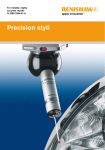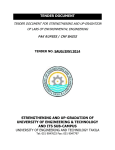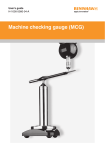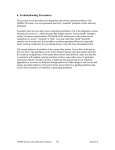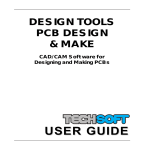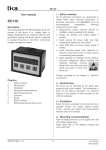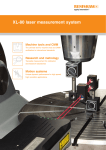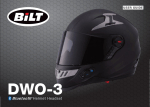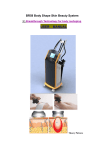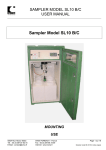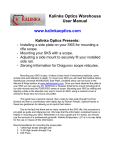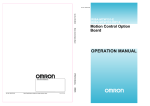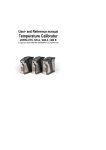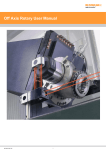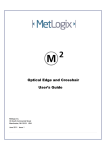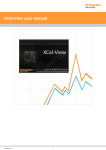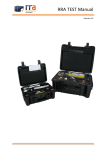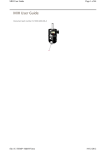Download Styli User Guide - Resources For Manufacturing, Inc.
Transcript
RFM For reliable, highly accurate results H-1000-3304-01-A Resources For Manufacturing, Inc. Precision styli 2 RFM Resources For Manufacturing, Inc. Contents Chapter 1 The importance of styli for precise measurements . ....................... 4 Chapter 2 Selecting and using styli components ....................................... 8 Chapter 3 Selecting and using styli ................................................ 38 Chapter 4 Calibrating styli......................................... 48 Chapter 5 Summary of key criteria for using styli components ...................... 52 Quality assurance from A – Z: Checking a range of styli balls 3 Chapter 1 RFM Resources For Manufacturing, Inc. The importance of styli for precise measurements Quality assurance standards have increased dramatically in recent years. Companies can only remain competitive if they deliver top-class process stability and superior quality – and all as rapidly as possible. Quality assurance and co-ordinate measurement technology are playing a crucial role in these processes. To stay competitive, manufacturers have been continually upgrading their co-ordinate measuring machines. CMMs are now being integrated directly into manufacturing as part of production processes and swift, high-performance scanning systems guarantee extremely precise measurements within the tightest timeframes. Renishaw and its probing systems have always been at the forefront of these developments. The quality of styli and accessories plays a vital role in industrial measurement technology, which is why, in this manual, we have summarised key information on the subject for your benefit. We hope that you find reading it productive! Yours Renishaw plc 4 RFM Chapter 1 Resources For Manufacturing, Inc. Renishaw styli provide high-tech precision and superior quality 5 RFM Chapter 1 Resources For Manufacturing, Inc. The stylus is the first link between CMM and work piece Z Y 6 X RFM Chapter 1 Resources For Manufacturing, Inc. What is a stylus? In principle, styli are the CMM’s “tools”, providing the same relationship that turning tools have with lathes, and milling and boring tools have with milling machines. When measuring with a touch-trigger probe, the machine uses the stylus to take the data points on the surface of the work piece. Each touch generates a point that is defined using coordinate values in X, Y and Z. Feature, size, form and position can then be computed from these points. By contrast a scanning probe takes continuous readings along the surface of a work piece. Sophisticated software uses this data to compute the size, position and form of features on the component. How do you choose the right stylus components? Chapter 2 gives details of all the main parameters and material properties. As you can see, the stylus is the first link with the work piece. This is why it is vital that the stylus delivers the greatest possible accuracy at the point of contact. 7 Styli and accessories for all measurement applications Thread adaptors can provide flexibility, e.g. you can use M2/M3/M4 styli on M5 connecting threads 8 RFM Chapter 2 Resources For Manufacturing, Inc. Selecting and using styli You should be very careful to select the stylus that is best suited to your measurement application. This chapter describes the main types of styli and accessories, and the key parameters and material properties. Connecting thread At a basic level, the choice of stylus always relates to the connecting thread on your coordinate measuring machine’s sensor – usually M2, M3, M4 or M5. Renishaw sensors work with connecting threads. M5 M4 Zeiss sensors mainly work with M5 and M3 connecting threads. M3 Styli can be used very flexibly with the help of thread adaptors e.g. you can use M2/M3/M4 styli on M5 sensor connecting threads. When choosing a stylus, the connecting thread is the decisive factor. Renishaw has the largest range of styli and accessories: M2 • with all connecting threads, • to suit sensors and accessories from all manufacturers • also, styli for probes for CNC machine tools. 9 RFM Resources For Manufacturing, Inc. Stylus configuration, mounted on an adaptor plate 10 RFM Chapter 2 Resources For Manufacturing, Inc. The geometry of the work piece determines the choice of stylus component A stylus must be able to easily reach all of the work piece’s probing points. You need to be very careful when choosing your stylus components, so they provide the required inspection criteria and accessibility for each feature measured. If you want to take all the measurements for a work piece on a co-ordinate measuring machine equipped with a fixed sensor, you often need a number of styli, mounted in different orientations, requiring different shaped styli components, extensions and knuckles. The combination of all these components is known as a stylus configuration, which is mounted on an adaptor plate. Renishaw produces stylus components in a range of materials, so you can assemble your stylus configurations so that they are ideally suited to the measurement application. A complex stylus configuration with multiple components When assembling your stylus configuration, you need to refer to the maximum mass that the sensor manufacturer has specified. The maximum mass can be up to 500 grams. 11 12 RFM Chapter 2 Resources For Manufacturing, Inc. Stylus types Renishaw offers the widest range of stylus types and accessories so that you can carry out all your measurements successfully. All components, including styli balls, are available in a range of materials. Chapter 3 provides a detailed description of stylus and ball materials. Straight styli Straight styli are the simplest and most frequently used type of stylus. Straight shouldered stems and tapered stems are available. Styli with tapered stems offer better rigidity when the work piece is easily accessible. Stylus balls are made from ruby, silicon nitride, zirconia, ceramic or tungsten carbide. The holders and stems come in a range of materials – titanium, tungsten carbide, stainless steel, ceramic and carbon fibre. Main application: For simple features with which direct contact can be made. Straight stylus, right-angled to the work piece surface To prevent stylus bending you should use the shortest stylus possible, particularly with touch trigger probe systems. The measuring travel direction should be near parallel to the coordinate axes and at right angles to the surface of the work piece. A wide range of accessories is available for aligning probes, e.g. for measuring angled holes. 13 Chapter 2 RFM Resources For Manufacturing, Inc. Star styli These are multi-tip stylus configurations with rigidly mounted styli. Balls are made from ruby, silicon nitride or zirconia. You can also configure your own star styli using stylus centres to mount up to 5 styli components. Star stylus with 5 rigidly mounted styli Measuring a complex interior contour 14 RFM Resources For Manufacturing, Inc. Main application: For surfaces and holes with which direct contact can be made. This configuration gives flexibility, enabling the tip to make contact with different features without changing the stylus. Different features can be reached with one stylus configuration 15 Chapter 2 RFM Resources For Manufacturing, Inc. Swivel styli This is a clamping mechanism that can be used to adjust styli to the required angle. Main application: For angled surfaces and angled holes, this configuration gives flexibility, enabling you to make contact with different features without changing the stylus. Flexible alignment for angled surfaces and angled holes 16 RFM Resources For Manufacturing, Inc. Disc styli These styli are ‘sections’ of highly spherical balls and are available in various diameters and thicknesses. Mounted on a threaded spigot, the discs are made from steel, ceramic or ruby. Full rotational adjustment and the ability to add a centre stylus are features of the range. This makes them particularly flexible and easy to use. Main application: These styli are used to probe undercuts and grooves within bores, which may be inaccessible to star styli. Probing with the ‘spherical edge’ of a simple disc is effectively the same as probing on or about the equator of a large stylus ball. However, only a small area of this ball surface is available for contact and hence thinner discs require angular alignment in order to ensure correct contact with the feature being probed. Disc stylus for measuring edges or undercuts A simple disc requires datuming for only one diameter, but this limits effective probing to only X and Y directions. Adding a ‘radius end roller’ allows you to datum and hence probe in the Z direction, provided that the centre of the ‘radius end roller’ extends beyond the diameter of the probe. The ‘radius end roller’ can be datumed on a sphere or a slip gauge. Rotating and locking the disc about it’s centre axis allows the ‘radius end roller’ to be positioned to suit the application. 17 Chapter 2 RFM Resources For Manufacturing, Inc. Semi-spherical disc styli These styli have a half-ball, or roller, mounted on each face of the disc, both beneath and on top, which guarantees point contact in the Z direction. Main application: Also for undercuts, stepped bores and grooves within bores. Using the hemispheres above and below you can also measure in the Z direction e.g. to measure the width of a groove. The edges of all discs are curved, as though a section had been cut out of a sphere at its equator. Measurement of diameter and width of the groove 18 RFM Chapter 2 Resources For Manufacturing, Inc. Cylinder styli Cylinder styli are made from tungsten carbide, ruby or ceramic. Main application: For measuring sheet metal, pressed components and thin work pieces with which proper contact cannot be guaranteed with ball styli. In addition, various threaded features can be probed and the centres of tapped holes located. Ball-ended cylinder styli allow full datuming and probing in X,Y and Z directions, thus allowing surface inspection to be performed. Cylinder styli e.g. for measurement of metal sheets 19 Chapter 2 RFM Resources For Manufacturing, Inc. 20 RFM Chapter 2 Resources For Manufacturing, Inc. Ceramic hemispherical styli Their advantage is that they have a large effective ball diameter with minimal weight. Main application: For measuring deep features and bores. Suitable also for contact with rough surfaces, as the roughness is mechanically filtered out by the large diameter surface. Measurement of a deep threaded bore Probing with such a large diameter ball can average out the effects of very rough surfaces 21 Chapter 2 RFM Resources For Manufacturing, Inc. Adaptor plates If you need to measure certain features repeatedly, it is a good idea to set up the required styli configurations on adaptor plates. You can store the assembled adaptor plates in styli cabinets, or racks on the CMM and use them when needed. Whenever you make a change, there is no need to recalibrate the probe so you can start measuring immediately. With a probe rack, even highly complex work pieces can be measured in CNC mode. Adapter plate for Renishaw SP 80 probe head Adapter plates for Zeiss VAST probe heads 22 RFM Chapter 2 Resources For Manufacturing, Inc. Accessories Accessories are useful for adapting probe components more precisely to specific measuring tasks. Renishaw offers an extremely wide range of accessories. Due to lack of space we can only show a few examples on this page, but our product catalogue shows the entire range. Bodies, cubes Combine to create specific styli configurations Knuckles The angular alignment of the probe component for making vertical contact with angled work piece surfaces or angled holes. Knuckles must be extremely stable and precisely machined if the probing force is not to alter the position of the stylus tip while measuring. Quality of design and materials is vital. 23 Chapter 2 RFM Resources For Manufacturing, Inc. Extensions Renishaw manufactures a wide range of extensions in different lengths and materials – steel, titanium, aluminium, ceramic and carbon fibre. Main application: Extensions are used for measuring very deep features and bores, or probing points that are difficult to access. 24 RFM Resources For Manufacturing, Inc. Extensions made from carbon fibre As is the case with stylus components, the choice of the material of extensions is important in metrology. With long extensions in particular, you need to pay close attention to the material’s thermal characteristics. 25 Chapter 2 RFM Resources For Manufacturing, Inc. Materials used for Renishaw stylus components Our product range caters for the widest range of material combinations. All the materials used in metrology are described below. Holders The stylus stem is attached to a threaded holder. Steel and titanium are the ideal materials for holders. Titanium is far lighter than steel and should be used when a light weight assembly is required. 26 RFM Chapter 2 Resources For Manufacturing, Inc. Stem The stem must be designed for maximum rigidity to minimise bending during measurement. Tungsten carbide Provides exceptional rigidity, particularly with small stem diameters and shouldered probes. With large stem diameters and long styli you need to be careful about the weight. Ideally suited for most standard applications. Ceramic Due to its lightness, ceramic is mainly used for long styli. It is thermally stable, for production-related applications. It can also be used as a break protection in machine tool applications. Steel For styli with superior rigidity for standard applications where weight is not an issue. Carbon fibre (thermally stable) Also ideally suited for long styli as carbon fibre styli only weigh around 20% of tungsten carbide styli. Its thermal stability delivers huge benefits, particularly with very long styli and this makes it suitable for use in a production environment. 27 RFM Resources For Manufacturing, Inc. 28 RFM Chapter 2 Resources For Manufacturing, Inc. Parameters for materials for extensions/plate extensions are similar to those for the stylus stem Tungsten carbide Deflection-resistant carbide stems for all standard applications at stable ambient temperatures, primarily for the use in the measuring room. Steel Extension with superior rigidity for standard applications where weight is not an issue. Aluminium Very light, so in principle ideally suited for extensions, but only in a stable air-conditioned environment due to thermal growth. Ceramic Light, solid, thermally stable, for use in production-related applications. Carbon fibre (thermally stable with low mass) The high-tech material for long extensions is an absolute must where there are temperature fluctuations. Our 20 mm diameter extensions enable the assembly of probe configurations with great flexural rigidity. Titanium Compared with aluminium, thermally stable, good flexural rigidity, very light! So very suitable for long extensions. 29 RFM Chapter 2 Resources For Manufacturing, Inc. Special characteristic of our thermally stable extensions The connecting components are made from titanium with a positive thermal expansion coefficient, whilst the extension tube is made from carbon fibre with a negative thermal expansion coefficient. The two components are designed to match one another so that when heat is applied, the carbon fibre contracts by the same amount by which the titanium expands. The outcome is that these extensions suffer little expansion, even with extreme temperature changes of between 15 and 40 degrees Celsius. Carbon fibre with negative thermal expansion and Titanium caps with positive thermal expansion 15 ºC 30 40 ºC RFM Chapter 2 Resources For Manufacturing, Inc. Materials for connecting components Titanium We supply the larger M5 accessories, such as knuckles and cubes, in titanium to keep the products very light. 13 g 11.2g Steel The smaller products are usually made from stainless steel Bear the following in mind: The materials shown here influence the product’s price. However, when choosing your styli and associated components, you should always give priority to the measuring application and the ambient conditions. Erroneous measurements waste time and money! 31 Chapter 2 RFM Resources For Manufacturing, Inc. Choice of material for styli components and accessories The key criteria when choosing a material are: • ambient conditions • length/flexural rigidity • the permitted masses specified by the sensor manufacturer This chapter provides information about the materials that should be used. Fluctuations in temperature can cause serious measurement errors. If you are operating your CMM in an airconditioned area at a stable 20 degrees C, this effect does not generally occur (except for extreme extensions). Otherwise, fluctuations in temperature always cause significant thermal expansion and changes in the length of the probe component or extension, and so lead to measurement errors, unless compensated for. Bear in mind, too, that even minor differences in temperature, can cause measurement errors. You can minimise such errors by choosing the right material for the stylus stem or the extension. 32 Chapter 2 Very long extension, made of carbon fibre 33 RFM Chapter 2 Resources For Manufacturing, Inc. Calculating changes in length Changes in length depend on the change in temperature, the length of the stylus shank being used and the expansion behaviour of the material. The change in length is calculated by ∆ L = ∆ L = L = α = ∆ t = L × α × ∆ t change in length probe length expansion coefficient difference in temperature ∆ L in µ Aluminium Steel Titanium Tungsten carbide CFK Thermal length increase in µ with a 200 mm probe extension and a temperature difference of 1K Bear in mind that you are measuring in the µ range! 34 Comparison of materials Heat coefficient/Mass Material Tungsten carbide: Ceramic: Titanium: Steel: Aluminium: CFK: Density (g/cm3) 14.8 3.9 4.5 7.85 2.56 1.52 Thermal Expansion 5.0 x 10-6 K-1 7.0 x 10-6 K-1 5.5 x 10-6 K-1 16.0 x 10-6 K-1 23.8 x 10-6 K-1 ~ 0,4 x 10-6 K-1 25 23,80 Expansion coefficient (10-6 K-1) Density (g/cm3) 20 16,00 14,80 15 10 8,20 7,85 7,00 5 5,00 3,90 4,50 2,56 1,52 0 Tungsten carbide Ceramic Titanium Steel Aluminium Carbon Fibre Thermal length increase in µ with a 200 mm probe extension and a temperature difference of 1K 35 RFM Resources For Manufacturing, Inc. You should always use carbon fibre for very long extensions, as in these cases even tiny temperature differences could otherwise cause major measurement errors. 36 As you can see, there are major variations in terms of both thermal expansion and weight between the different materials. Carbon fibre offers the ideal combination of minimal mass and greatest temperature stability. RFM Chapter 2 Resources For Manufacturing, Inc. Flexural rigidity The stylus stem must be designed for maximum rigidity. During probing, measuring forces occur that must not cause the stylus to bend excessively, as this can directly impact on the machine’s measurement uncertainty, particularly with dynamic measurements (scanning) that simultaneously probe in all spatial directions. The bottom line: styli should be as stiff as possible! Low deflection Excessive deflection Deflection has a direct impact on the accuracy of measurement Materials’ flexural rigidity compared In materials technology, the elastic modulus is a material characteristic that describes the relationship between tension and expansion when a solid body is deformed. As the value of the elastic modulus increases the more resistance a material presents to being deformed. So a material with a high elastic modulus is rigid, while a material with a low elastic modulus is flexible. Material Tungsten carbide Steel Aluminium Titanium Ceramic Carbon fibre E modulus in kN/mm 2 620 200 70 150 300 – 400 ≥ 450 37 38 RFM Chapter 3 Resources For Manufacturing, Inc. Selecting and using styli The choice of the ball material depends on the measuring strategy and the work piece material. Bear in mind the ball‘s quality rating – Renishaw only use balls in the top precision category, grade 3 to grade 5. Ruby After diamond, ruby is one of the hardest materials known, so it is an ideal material for balls in most standard applications. Silicon nitride Silicon nitride is very similar to ruby in terms of its technical properties. It is an exceptionally wear-resistant ceramic material that can be shaped into perfect balls whose surface can be polished until it is extremely smooth. Silicon nitride is not attracted to aluminium. For this reason, the material is ideally suited for scanning aluminium surfaces as, unlike with ruby, aluminium particles from the aluminium surface are not deposited on the ball. Zirconia The special nature of this material’s surface makes it perfect for scanning the surfaces of abrasive work pieces such as cast iron parts. 39 Chapter 3 RFM Resources For Manufacturing, Inc. Typical coating of impurity on a ruby ball after 350 m of scanning The same ball after being cleaned with a dry, lint-free cloth 40 RFM Chapter 3 Resources For Manufacturing, Inc. Notes on scanning With point measurements, the ball only comes into contact with the component’s surface for a very short time. Scanning is different as the ball slides along the surface of the work piece. Because the contact is continuous, there is a prolonged sliding contact between the ball stylus and the surface of the work piece. Ball stylus wear and tear and ball stylus deposits left by scanning can affect measurements Renishaw has run an extensive research programme to examine the interaction between ball materials and work piece surfaces. Impurities All the tests with ball materials have shown that materials are deposited on ball surfaces. Between inspections, it is recommended that the balls are cleaned with a dry, lint-free cloth so that no residue is left. 41 Chapter 3 RFM Resources For Manufacturing, Inc. The scratches on the surface of this ruby ball are clearly visible A coating of aluminium is clearly visible on this ruby ball 42 RFM Chapter 3 Resources For Manufacturing, Inc. Abrasive wear (scanning abrasive materials) If, for example, components made from cast iron are being measured, both the ball stylus and the surface of the work piece can suffer wear from abrasion. Minute particles of residue can cause fine scratches on the ball stylus and the surface of the work piece. We recommend zirconia ball styli for this type of application to minimise this affect. Adhesive wear (scanning aluminium parts) When a ruby ball is used to scan an aluminium surface, the two materials attract one another. The material is usually passed from the softer surface to the harder surface. This means that aluminium is deposited on the surface of the ball and the coating of aluminium can be seen clearly after only 100 m of continuous measurement using a single contact patch on the stylus ball. We recommend ball styli made from silicon nitride for this type of application. This material repels aluminium, so the deposit effect rarely occurs. 43 44 RFM Chapter 3 Resources For Manufacturing, Inc. Ball precision (grade) A ball’s grade is a rating that describes the precision class of the ball used. Precision classes range from grade 48 (the lowest precision class) to grade 3 (the highest). Renishaw use grade 3 and grade 5 balls. Table of precision classes Grade 20 16 10 5 3 Dw(Ø) ø deviation ± 0.50 µm ± 0.40 µm ± 0.25 µm ± 0.13 µm ± 0.08 µm Dw(Ø) Dw(Ø) Roundness 0.50 µm 0.40 µm 0.25 µm 0.13 µm 0.08 µm Dw(min) Dw(min) Dw(min) Nominal ball diameter DW The diameter value used to identify the ball size. Dw(max) Dw(max) Dw(max) Rc Rp Ø Deviation The difference between the largest and smallest diameters of one ball. The roundness deviation (the ball’s form defect) directly impacts on measurements. Rc Rp Rc Rp Deviation Roundness The greatest radial distance in any radial plane between a sphere circumscribed around the ball surface and any point on the ball surface. Diameter tolerances are almost insignificant for 3D metrology because the effective ball stylus centre and diameter are established during the calibration process. (see Chapter 4) 45 Chapter 3 RFM Resources For Manufacturing, Inc. Spigot mounted styli Spigot mounted balls guarantee top-class stability and a long service life 46 RFM Chapter 3 Resources For Manufacturing, Inc. Cap or spigot ball assembly Basically there are two options for connecting the stem to the ball – a cap connection or a spigot connection. The majority of Renishaw styli are manufactured using the spigot mounted design. This means that we drill holes in the balls down to 0.5 mm diameter, grind spigots on the shafts and bond the balls to the spigot. The advantage is clear – the bond is technically superior in engineering terms and, particularly with slim stems – there is a greater gluing area. Particularly with slim stems, because of the limited gluing area, conventional bonding methods can result in the ball quickly separating from the stem when even a minimum of force is exerted. Our Grade 3 (0.08 μm spherical form deviation) ball styli are constructed using an undrilled ball bonded into a spherical cup Investigations into the effect of the design and construction of styli using such a highly specified ball, have indicated that the form of the ball can be degraded by both machining a hole in it and through distortion from gluing it onto a spigot. Measurements taken before and after assembly have shown that the form of the ball remains well within specification throughout the process. Due to limits of measurement capability and bond strength, Grade 3 ball styli are only be available with a minimum diameter of 1 mm. AA BB Glue A: Cap connection, less gluing area B: Spigot connection, greater gluing area and safety due to spigot It is important that a manufacturer ensures that spigot lengths and bore depths match. If the hole is too deep, air gets captured and the balls come loose very quickly when measuring in Z directions. If the spigot is too long, the bottom of the bore becomes conical or round so that air pockets will probably occur and cause a lack of stability. 47 48 RFM Chapter 4 Resources For Manufacturing, Inc. Calibrating styli Before you begin taking measurements, it is crucial that you calibrate the probe precisely for all your measurement procedures. The effective dimensions of the probe components have to be established if accurate results are to be obtained. These values are stored in the CMM’s data processor. How it works The position of the individual ball styli and their diameters are established using a special probe calibration programme (see the machine manufacturer’s user manual). You contact a reference point with all the styli to be used, one after the other. The reference used is usually an extremely precise, manufactured ball with a known diameter. The exact dimensions of the ball being calibrated are input to the measuring software. If the styli are to be used for measuring separate points, the stylus is calibrated using a number of points on the reference ball’s cardinal points (see image). A far greater number of points are taken for scanning systems. The machine manufacturer’s user manual will describe the precise probing strategy for calibrating the styli. Make sure, particularly if you are using more than one CMM, that you use the calibrated ball whose values have been input to the software. 49 Chapter 4 RFM Resources For Manufacturing, Inc. Outcome The probe calibration procedure establishes the stylus tip’s effective diameters when measuring, and their positions in relation to one another and to the machine’s co-ordinate system. A special analysis program and the known diameter of the calibrated ball are used to establish the unknown diameters of the stylus tip. The co-ordinates of the centre of the first stylus ball calibrated are stored in the CMM’s data processor as reference co-ordinates. All the remaining tip positions are established by generating differences with the first one, and then also stored as ball centre coordinates. Once the various tips of a stylus configuration have been calibrated, their centre points are compensated for by the CMM software, so that measurements with all the styli appear as though they had been taken with just a single stylus. This means that whichever stylus you use to probe a point, you always get the same result. When taking measurements, the CMM compensates for the stylus position and tip dimensions. This leaves just the form of the stylus tip as the only factor influencing the measurements. 50 RFM Chapter 4 Resources For Manufacturing, Inc. Calibrating other shaped components Apart from reference balls, stylus calibration can also be done using other references such as end gauges, ring gauges and pin gauges. Typical examples are with cylinder and disc styli. The basic principle does not alter. The machine manufacturer’s user manuals will describe the routines for these types of calibration. Reference stylus 51 52 RFM Chapter 5 Resources For Manufacturing, Inc. Summary of key criteria for using probe components In the CMM sector, all the equipment manufacturers invest heavily in keeping measurement uncertainty to a minimum. This is also often reflected in the high cost of investing in CMMs. The performance of your gauging can easily be degraded if you use a stylus with poor ball roundness, poor ball location, bad thread fit or a compromised design that allows excessive bending during measurement. To ensure the integrity of the data you gather, make certain that you specify and use a stylus from the comprehensive range of genuine Renishaw styli. 53 Checklist Always use styli that are as short and stable as possible! With long styli components, ensure that they have the required stability. Check that the styli you use have no defects, particularly on the thread and the seating area. This will ensure that the mount is very secure. Variations? Check that the probe component is firmly attached. Replace worn styli! Are you using components that are thermally stable? Bear in mind the ambient conditions. When putting together stylus configurations, refer to the permitted masses as specified by the sensor manufacturer. Avoid too many or superfluous thread connections. Use the lowest possible number of separate components. 54 Do you have scanning applications? Take advantage of the benefits offered by silicon nitride balls when scanning aluminium! Use the largest possible balls. Large ball styli act as mechanical filters on the surface of the work piece. The fine structures on the surface of the work piece are scarcely recorded with large balls, which prevents random measurement variations (flyers). Styli should always be aligned at right-angles, or as close to a right angle as possible, to the planes being measured. For angled measuring planes, angled cubes and knuckles are available to ensure that styli are accurately aligned. The same applies when measuring angled bores! Ensure that the measuring force and dynamics suit the stylus components. With small ball styli with a slim stem, you should reduce these values when necessary. 55 RFM Resources For Manufacturing, Inc. Notes 56 [email protected] www.renishaw.com Renishaw applies innovation to provide solutions to your problems Renishaw is an established world leader in metrology, providing high performance, cost-effective solutions for measurement and increased productivity. A worldwide network of subsidiary companies and distributors provides exceptional service and support for its customers. Renishaw designs, develops and manufactures products which conform to ISO 9001 standards. Renishaw provides innovative solutions using the following products: • Probe systems for inspection on CMMs (co-ordinate measuring machines). • Systems for job set-up, tool setting and inspection on machine tools. • Scanning and digitising systems. • Laser and automated ballbar systems for performance measurement and calibration of machines. • Encoder systems for high accuracy position feedback. • Spectroscopy systems for nondestructive material analysis in laboratory and process environments. • Styli for inspection and tool setting probes. • Customised solutions for your applications. © Renishaw plc 2008. All rights reserved. Renishaw worldwide Australia T RFM Resources For Manufacturing, Inc. P.O. Box 751432 Dayton, OH 45475 Ph: (937) 436-4699 Fx: (937) 436-9244 [email protected] www.RFMInc.net [email protected] Printed in Germany Part No. H-1000-3304-01-A

























































